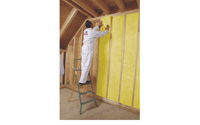

A continuing rise in timber frame construction has led to the launch of a new product range by leading insulation manufacturer, URSA UK.
After a challenging period during the recession, timber frame construction is making a hugely successful comeback. As well as the usual benefits of speed of construction and the use of off-site construction, timber frame is also more attractive under the new, more rigorous Building Regulation requirements.
Recent figures from a research report by MTW Research suggests that timber frame frame sales will grow by 60% in volume and 80% by value, to £762.6m, in 2016. The main area of growth will be in the house building sector but add to this the increasing use of timber frame in non-domestic areas such as health and education. Research by Arch Vision in the Netherlands predicts the growth of timber frame across Europe – in the UK 59% of the architects surveyed predicting greater use of timber frame.
In direct response to this growing trend and customer requirements, URSA has launched its Timber Frame Slab 35 and Timber Frame Slab 32, offering contractors an alternative to their existing glass wool roll versions. URSA Timber Frame Slab is a semi rigid slab designed to slot neatly and firmly between the timber studs. It is available in two grades with thermal conductivities of either 0.035 W/mK or 0.032 W/mK and supplements the existing URSA Timber Frame Roll products for use in this application.
David Kemp, Commercial Manager UK & Ireland, for URSA UK said: “We are working with more and more major UK housebuilders and many of the projects that we are supplying to and/or sending further information for are related to timber frame. We are always quick to respond to market demand and the launch of the slab product offers a complete range of timber frame products.”
David added: “There has always been an argument surrounding timber frame versus masonry build and there are certainly some strong benefits associated with the environment and whole life concerns, in favour of timber frame. Across the board we are seeing a growing demand for our higher performing products, with customers largely wanting their properties to run more efficiently, be more economical and sustainable. A shift towards timber frame may well be synonymous with current trends that favour an environmentally sound build.”
Timber frame construction offers enhanced fabric performance with lower U-values, lower thermal mass and enhanced air tightness compared to traditional masonry construction. The nature of timber frame means that it is easier to add additional insulation, either internal or external to the studs and improve the U-value.
The lower thermal mass of timber frame compared to masonry also has advantages when complying with Building Regulations achieving a quicker response time in conjunction with a correctly designed and controlled heating system resulting, in less energy use further reducing CO2 emissions.
With increasing levels of insulation, unwanted air infiltration becomes a major heat loss source. Traditional masonry construction can be very ‘leaky’ with mass air movement possible even through some types of block, further adding to the problem here is the predominance of dry internal finishes with no ‘sealing’ effect of a wet plaster finish or parge coat. Timber frame construction normally includes an air and vapour control layer (internally) and breather membrane (externally) and these add considerably to the overall air tightness of a timber frame building.